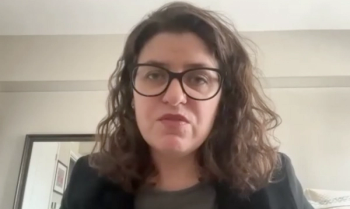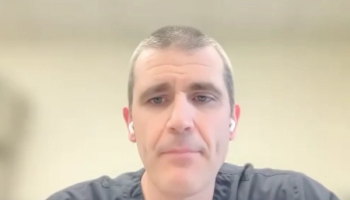
Dr. Ekene Enemchukwu on OAB/incontinence research from AUA 2021
“I think this AUA was really exciting for anyone that treats OAB and incontinence because there were a number of really interesting studies,” says Ekene Enemchukwu, MD, MPH.
In this video, Ekene Enemchukwu, MD, MPH, discusses several notable studies regarding overactive bladder/incontinence from the 2021 American Urological Association Annual Meeting. Enemchukwu is assistant professor of urology and, by courtesy, of obstetrics and gynecology and medical director of the Stanford Pelvic Health Center at Stanford University, Palo Alto, California.
Transcript
PD66-05: Safety, feasibility, and accuracy of the uromonitor: a catheter-free wireless ambulatory cystometry device
I think this AUA was really exciting for anyone that treats OAB and incontinence because there were a number of really interesting studies. One that immediately comes to mind was a proof-of-concept study that was presented by Dr. Brendan Frainey out of Cleveland Clinic, in which they described a novel wireless catheter-free intravesical pressure sensor, a device they called the "Uromonitor." It's a device that can be used to perform catheter-free ambulatory bladder monitoring—basically urodynamics without catheters. The electronics are flexible and housed in this medical grade silicone, and it's inserted transurethrally, the same way that you would insert a Foley catheter. And then you go in with a flexible scope, just to make sure that it's in the correct spot. The way they've designed this is that it's got a silk suture that is secured at the end for easy retrieval when the study is completed. The data is collected and can be wirelessly transmitted to a computer or laptop by Bluetooth.
Their aims are really to evaluate the efficacy, the accuracy, and the safety and tolerability of this device. They studied it in 8 adult women who all underwent baseline UDS urodynamics first. Then, the Uromonitor was placed and urodynamics was repeated. At the end of the study, the Uromonitor was extracted using an attached suture. In terms of the accuracy aim, they found that the Uromonitor actually collected 98% of UDS events, and there were no significant differences in UDS parameters, such as bladder capacity and flow rate, when compared to the standard urodynamic equipment. In terms of safety and tolerability aims, the patients reported that the most painful part was the flexible cystoscopy, which was used to confirm the device placement. Hopefully, in future iterations, that may not be needed. But the patients actually tolerated the device placement very well and had visual analogue scores of zero post-procedure and 48 hours after the procedure. Also, it was notable that there were no UTIs, no post-procedure adverse events, though they didn't mention whether any pre-procedural antibiotics were given or not.
Most people probably wonder what happened in terms of the device. Did it get voided out during the study? There were 2 patients that did void the device out, but it was easily replaced with a sterile device. So, we talk about the limitations of urodynamics all the time, the inability to perform ambulatory urodynamics, the need for catheters, lack of privacy. Other times you put patients through this test, and you get a non-diagnostic study. Imagine if we could perform over 24 hours, or even 72 hours, an ambulatory urodynamic study with bladder diaries to get a better sense of what our patients are experiencing. I think it's very exciting to think about the possibilities here, but certainly more studies are needed.
MP52-11: Patient-reported onset of symptom improvement following initial intradetrusor onabotulinumtoxina injections for overactive bladder
Another study that I want to highlight is also out of Cleveland Clinic. This one was presented by Dr. Jacqueline Zillioux and her colleagues. This was a non-randomized, prospective, observational study evaluating the onset of symptom improvement after onabotulinumtoxinA injection. Prior studies show that there's some improvement by the 2-3 week follow up visit, but it wasn't clear when these patients actually start to get some improvement. So, in this study, after the injections, they had patients complete a patient global impression of improvement, or PGII, daily for 21 days. They evaluated 51 consecutive patients and found that 94% reported improvement by 3 weeks. Their subjects reported being a little better by a median of 3 days, much better by a median of 5 days, and had max improvement by a median of 7 days. This is really helpful information for counseling our patients.
PD66-01: Treatment of urinary urgency incontinence (UUI) with an ultra-miniaturized sacral nerve modulation (SNM) system: preliminary outcomes of the SANS-UUI study
In another study presented by Dr. Steven Siegel and his colleagues, they report the initial results of a battery-less, ultra-miniaturized, sacral neuromodulation system. It's essentially a 5-centimeter quadripolar lead that is implanted in a single stage and wirelessly powered by an external device for a few hours daily. Their aims are really to determine the efficacy of this device, patient compliance, and what the stimulation duration should be. So, in a multicenter, open-label trial of OAB patients, the subjects were asked to stimulate for 2 hours a day after device implantation. If they have less than a 50% response after 3 weeks, they could increase their stimulation to 4 hours per day.
They enrolled 39 patients from 11 centers, 3 of them in Europe, and they implanted 34 patients, 94% of which were women. Thirty-three patients completed the 2-hour daily simulation and had a greater than 50% improvement, and 1 needed to increase the 4 hours per day. At 1 month, they had an 85% responder rate which increased to 90% at 6 months. I thought it was also impressive that they noted an 80% reduction in urge urinary incontinence episodes, and 36% of patients were dry at 6 months. They had about 25 adverse events in 11 patients. Three of these were lead fractures and 2 were lead dislodgements. Most of the adverse events were site pain or uncomfortable stimulation. They concluded that the device is safe, effective, and can be used for 2 hours of stimulation per day, and that they're currently working on a shorter implant model to address the device fracture and dislodgement issues. I'm definitely looking forward to the sham control trial for this study and having another staple neuromodulation option for our patients.
AUA Live Session: OAB Overview
Finally, I will touch on the AUA live session that was moderated by Dr. David Ginsburg. The panelists were Dr. Victor Nitti, Dr. Kathleen Kobashi, and Dr. Eric Grosvenor, and they gave a nice overview on OAB diagnosis, treatment, patient selection, tips and tricks, and advice for mitigating the barriers to OAB therapy adherence. The highlight of that session, in my opinion, was really discussion about setting patient expectations and the importance of understanding the patient's goals and not what we think are the patient's goals. And so, Dr. Grosvenor talked a little bit about questionnaires such as the SAGA questionnaire, which can be helpful. They also highlighted the importance of combining behavioral therapy with all lines of therapy, and published data showing that patients actually do better when they undergo group behavioral therapy rather than just receiving a handout in clinic. In that session, Dr. Grosvenor also highlighted an exciting new gene therapy on the horizon—the URO-902 gene therapy plasmid vector.
MP63-05: A randomized controlled trial comparing telemedicine versus in-person office visits for the follow-up of overactive bladder.
I'll end with 1 more study, which is a study that's looking at the use of telemedicine for overactive bladder patient follow up. This is a study from Stonybrook, in which they randomized 46 patients to telemedicine versus in-person visits. The authors found that there was no difference in follow up rates at 30 days or 60 days. They also found there's no difference in satisfaction rates, though the telemedicine group did have a perfect 100% satisfaction rate. In addition, they found that telemedicine visits seem to take half the length of time of in-person visits and that patients saved approximately 1 hour in travel time. So, they concluded that telehealth visits didn't really change follow up rates but may save time for both the patients and probably the provider, too. This is an exciting AUA for anyone that treats OAB. There's a lot of new therapies on the horizon. With COVID, we're certainly looking to utilize and leverage telemedicine to help improve satisfaction with our patients and to improve efficiency in our clinics. So, if you haven't had a chance to check out these sessions, I strongly recommend it.
Newsletter
Stay current with the latest urology news and practice-changing insights — sign up now for the essential updates every urologist needs.























